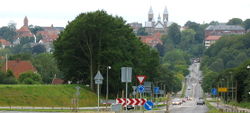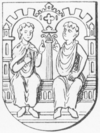Viborg, Denmark
| Viborg | |||
|---|---|---|---|
 |
|||
|
|||
 Viborg
|
|||
| Coordinates: | |||
| Country | Denmark | ||
| Region | Region Midtjylland | ||
| Municipality | Viborg municipality | ||
| Earliest evidence | 8th century | ||
| Government | |||
| - Mayor | Søren Pape Poulsen (Det Konservative Folkeparti) | ||
| Area | |||
| - City | 1,474.05 km2 (569.1 sq mi) | ||
| Population (2007)[1] | |||
| - City | 91,405 | ||
| - Density | 62.0/km2 (160.6/sq mi) | ||
| - Urban | 34,522 | ||
| Time zone | CET (UTC+1) | ||
| - Summer (DST) | CEST (UTC+2) | ||
| Website | http://www.viborg.dk/ | ||
Viborg (Danish pronunciation: [ˈʋib̥ɒːˀ]), a town in central Jutland, Denmark, is the seat of both Viborg municipality and Region Midtjylland. Viborg is also the seat of the Western High Court, the High Court for the Jutland peninsula. Viborg Municipality is the second largest municipality of Denmark, covering 3,3% of the total land area of Denmark.[2]
Contents |
History
Viborg is one of the oldest towns in Denmark, with Viking settlements dating back to the 8th century. Its central location gave the town great strategic importance, in political and religious matters, during the Middle Ages. A motte-and-bailey-type castle was once located in the town. Viborg takes its name from a combination of two words: Wii, meaning a holy place, and berg, meaning a hill.
Sights
Viborg is famous for Viborg Cathedral. The construction of the cathedral started in 1130 and lasted about 50 years. The building has burned to the ground and been re-built several times. Only the crypt of the original cathedral is still preserved. The newest parts of the church are from 1876. The cathedral is famous for its many paintings by Danish painter Joakim Skovgaard, which depict stories from the Bible. Next to the cathedral is the Skovgaard museum, founded in 1937.[3]
Before the Protestant Reformation Viborg was the home of five monasteries,[4] about 12 parish churches, several chapels and of course the cathedral. Today only the cathedral and a few remains of the Franciscan and the Dominican monasteries are left.
Sports
Viborg has over the last decade won a reputation as one of Denmark's leading cities for sports. It started with the city's women's handball team (a popular sport in Denmark), which continues to be one of Europe's top-5 clubs. Subsequently, both the men's handball team and most notably the professional football team have established themselves at the top of the Danish leagues. From 1998 to 2008, Viborg FF was a constant member of the Danish Superliga, reaching an all-time high when winning the Danish cup in 2000.
Education
Viborg is home to a number of educational institutions, including Viborg Katedralskole (cathedral school). Denmark's oldest educational institution celebrated its 900th birthday in the year 2000. The school is believed to have been founded about 1060 - at the same time as the city became a site of a bishop. The church needed to educate boys and young men to enter into the church's service, and to that purpose it created a school. Its current monumental home was built in 1926 to accommodate a larger number of students and later the school added a dormitory to house the many students from outer regions or islands not close to a gymnasium. Although this role is now basically obsolete, the dorm continues to be a popular solution for many students wanting to get away from home or for a small number of students from Greenland. Viborg Katedralskole is today one of four gymnasiums in Viborg.
Viborg is also home to The Animation Workshop, an art school based in a former army barracks on the outskirts of town. The school, which achieved official recognition from the Danish government in 2003, offers students a Bachelor of Arts in character animation.
Famous people
- Kjeld (died 1150), Archdeacon, canonized 1188
- Gunner (1152–1251), Bishop, cowriter of the Law of Jutland
- Knud Mikkelsen (the 15th century), Bishop, contributor to the Law of Jutland
- Peter von Scholten (1784–1854), Governor-General of the Danish West Indies
- Hans Christian Cornelius Mortensen (1856–1921), ornithologist
- Benjamin Christensen (1879–1959), film director
- Olaf Wieghorst (1899–1988), painter
- Johann Otto von Spreckelsen (1929–1987), architect
- Peter Seeberg (1925–1999), writer
- Peer Hultberg (1935–2007), writer
- Ulrik Wilbek (born 1958) handball coach
Images
|
Sankt Mogens Gade |
 Cathedral |
 Skovgaard's painting in the cathedral |
Sortebrødre kirke (former church of the Dominican priory) and the hospital |
In popular culture
In the science fiction book The Corridors of Time by Poul Anderson, a Danish-American writer who did considerable research on Danish history, a large part of the plot takes place in 16th-century Viborg. The main protagonist - an American time-traveller from the 20th century - arrives in the city in 1535 and gets involved with the adherents of the overthrown King Christian II and of the peasant rebel leader Skipper Clement, who face savage persecution in the city.
Viborg is also the setting of Room Number 13, a ghost story by the English writer M.R. James.
See also
- Chronicle of the Expulsion of the Grayfriars#Chapter 2 Concerning the Friary at Viborg
References
- ↑ "Viborg Kommune". http://www.viborg.dk/db/Kommune.nsf/Alle/9477EDB57BEB5E58C12572E600217769?OpenDocument.
- ↑ Viborg Kommune statistics
- ↑ Museum website
- ↑ one for Augustinian canons and one for Augustinian nuns, a Franciscan friary, a Dominican priory and a preceptory of the Knights Hospitallers
|
|||||||||||||||||
|
|||||||||||||||||||||||||||||||||||||||||||||||||||||||||||||||||||
